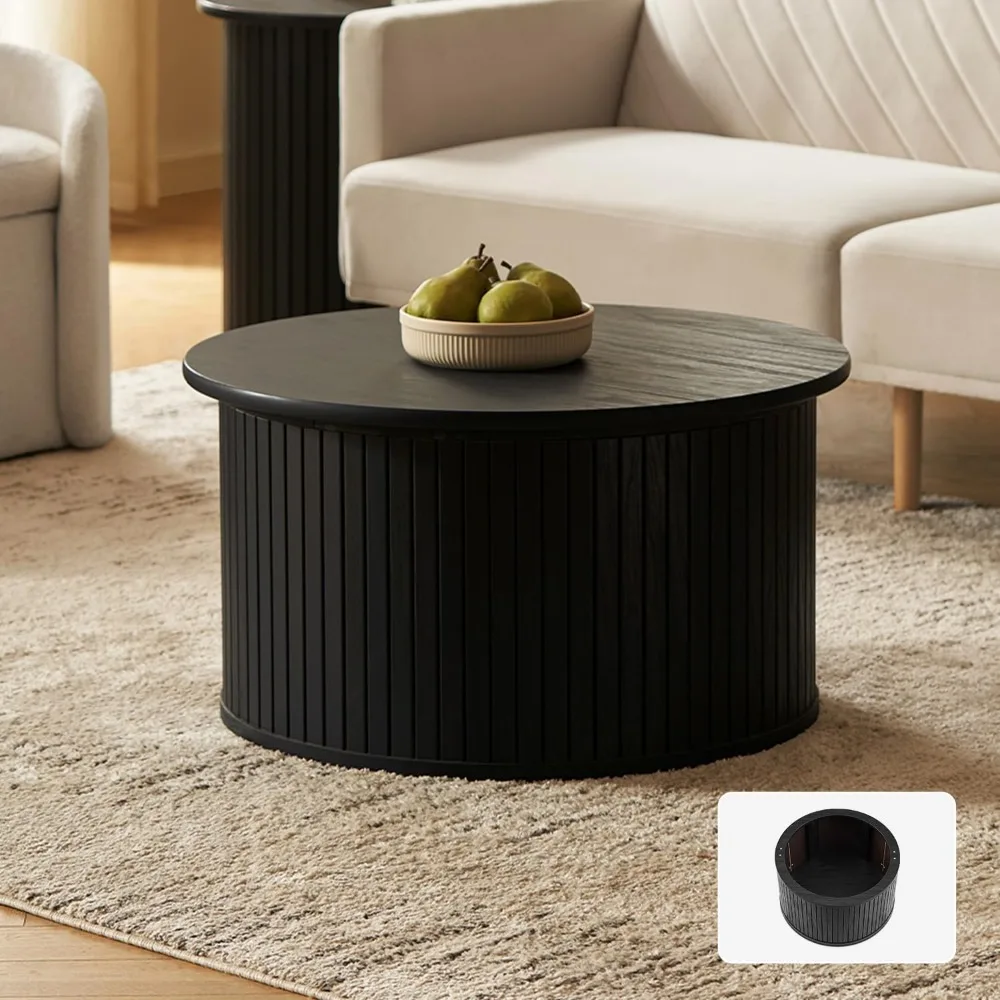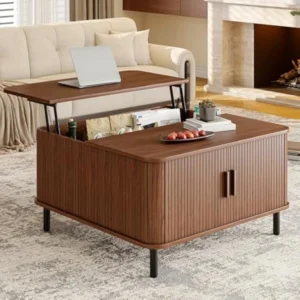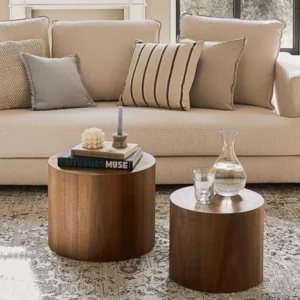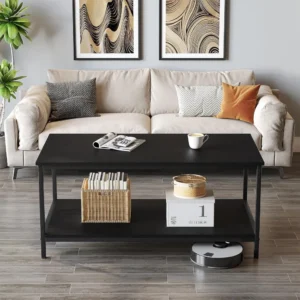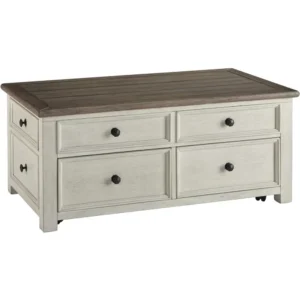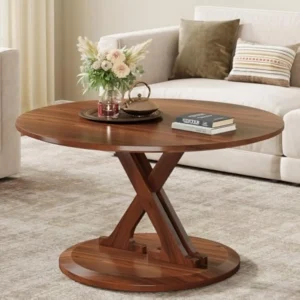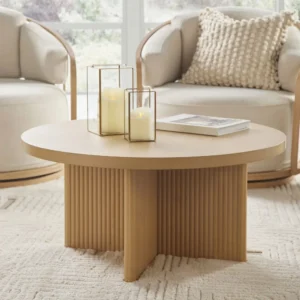The Perfect Pairing: Why Black Mid-Century Coffee Tables Work in Compact Living
Black mid-century coffee tables represent the perfect marriage of style and functionality for small living spaces. These elegant pieces are characterized by their sleek lines, organic forms, dark finishes, and highly functional design—attributes that make them surprisingly well-suited for compact areas.
Many homeowners worry that dark furniture will make their small spaces feel even smaller, but this is largely a misconception. When selected thoughtfully, a black mid-century coffee table can actually:
- Create a sophisticated anchor point that draws the eye without overwhelming the space
- Add depth and dimension through contrast with lighter elements
- Provide visual structure that helps organize a compact room
- Hide everyday wear and tear better than lighter finishes
Mid-century modern design emerged in the mid-20th century, emphasizing clean lines, organic curves, and a perfect balance between form and function. This design philosophy naturally lends itself to small-space living, as mid-century pieces were created during a time when efficient use of space was paramount.
Unlike bulkier furniture styles with ornate details or heavy proportions, intelligent black mid-century coffee tables feature raised profiles on slender legs that create airiness beneath, making rooms feel more spacious. Their simplified, purposeful designs avoid unnecessary ornamentation that can make spaces feel cluttered.
When incorporated thoughtfully, these tables don’t just accommodate small spaces—they enhance them. The timeless appeal of black mid-century coffee table design means these pieces can adapt to evolving decor preferences while maintaining their functionality and aesthetic appeal.
Essential Dimensions: Finding the Right Size for Your Space
Selecting the appropriate dimensions for your coffee table is crucial when working with limited square footage. The perfect table maintains proportion with your existing furniture while allowing comfortable movement around it.
For optimal balance, follow the golden ratio for coffee table-to-sofa proportions: your table should be approximately two-thirds the length of your sofa. Height matters too—ideally, your coffee table should sit at roughly the same height as your sofa cushions or 1-2 inches lower (typically 16-18 inches or 40-45 cm from the floor).
Before shopping, measure your available space carefully, accounting for pathways and clearance. Most interior designers recommend maintaining at least 12-18 inches (30-45 cm) of clearance around your coffee table to allow for comfortable leg room and easy navigation.
Use this measurement guide to find the perfect fit for your space:
| Space Size | Recommended Table Dimensions | Clearance Needed |
|---|---|---|
| Very Small (Studio) | 30-36 inches (75-90 cm) diameter or length | 12 inches (30 cm) minimum |
| Small Living Room | 36-42 inches (90-105 cm) diameter or length | 14-16 inches (35-40 cm) |
| Medium-Small Space | 42-48 inches (105-120 cm) length | 16-18 inches (40-45 cm) |
Remember that these are guidelines rather than rigid rules. Your specific room layout, furniture arrangement, and traffic patterns should inform your final decision.
When selecting dimensions, consider how the table will be used. Will it primarily hold decorative items, or do you need space for remote controls, books, and beverages? For versatile options perfectly sized for modest spaces, explore mid-century modern small coffee tables that balance proportions with functionality.
Strategic Shapes: Choosing the Right Silhouette for Flow
The shape of your coffee table significantly impacts both visual appeal and traffic flow in small spaces. Different silhouettes offer unique advantages depending on your room layout and functional needs.
Round/Oval Tables:
– Create smoother traffic flow with no sharp corners to navigate around
– Soften spaces with many linear elements
– Work well in tight quarters where corners might pose hazards
– Encourage conversation by allowing easier eye contact
– Pair beautifully with curved sofas or sectionals
Rectangular/Square Tables:
– Offer maximum surface area for items
– Create strong alignment with straight-lined sofas
– Work well in rooms with defined, linear layouts
– Provide clear organizational structure for displayed items
– Often include more storage options
Organic/Abstract Shapes:
– Add visual interest and unique character
– Can fit unusually shaped spaces or room layouts
– Create a distinctive design statement
– Often designed to nest or fit specific spatial challenges
– Reflect authentic mid-century organic design principles
For many compact settings, mid-century modern round coffee tables prove especially effective. Their curved edges create safer passage in tight spaces while maintaining the distinctive mid-century aesthetic. The absence of corners means people naturally flow around them, reducing the likelihood of painful shin encounters—a significant benefit in cramped quarters.
When selecting a shape, consider how people move through your space. Is there a clear pathway that needs to remain unobstructed? Would a rounded corner help prevent traffic jams in a particular spot? These practical considerations should inform your aesthetic choices.
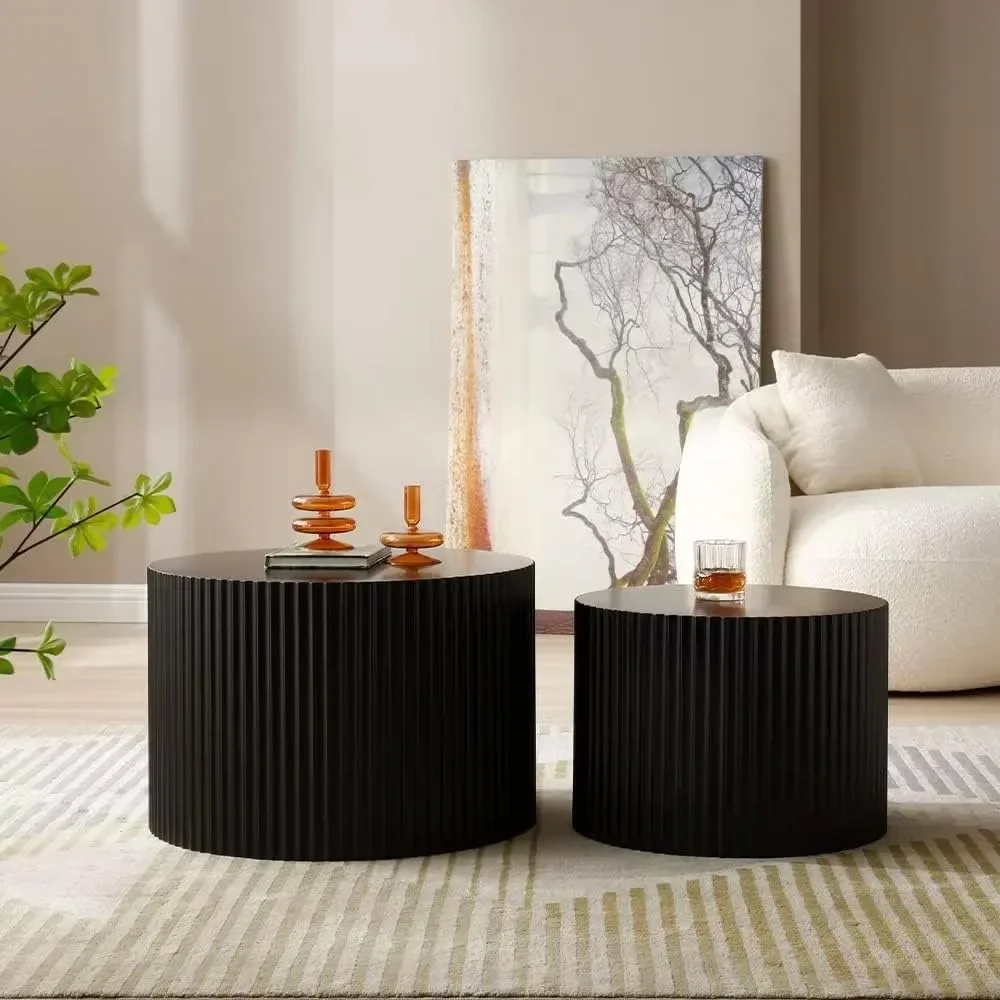
Design Features That Maximize Small Space Living
Black mid-century coffee tables often incorporate space-savvy design elements that make them particularly suited for compact living. When shopping, look for these functional features that serve both style and practicality:
Tapered or Splayed Legs:
– Create visual lightness by narrowing toward the floor
– Allow easy cleaning underneath
– Make the room feel more spacious with visible floor area
– Provide stability without visual heaviness
Open Shelving:
– Offers storage without appearing bulky
– Creates display space for books and decorative items
– Maintains visual airiness while increasing functionality
– Allows light to pass through, reducing visual weight
Hidden Storage Compartments:
– Conceal clutter in limited spaces
– Maximize functionality without compromising aesthetics
– Perfect for remote controls, magazines, or everyday items
– Maintain clean lines when closed
Lift-Top Functionality:
– Transforms coffee tables into work surfaces or dining areas
– Eliminates need for separate desk or dining table
– Adjusts to different height needs without additional furniture
– Perfect solution for multipurpose rooms
For particularly versatile options, mid-century modern lift-top coffee tables offer intelligent solutions that adapt to different activities throughout the day. These transformative pieces exemplify the practical ingenuity of mid-century design.
Nesting tables provide another smart solution, allowing you to expand surface area when needed and tuck away additional tables when not in use. Glass or reflective elements can also enhance the perception of space by bouncing light and creating visual continuity.
When selecting a table, consider which specific features of black mid-century coffee tables will best solve your unique space challenges. The right features can dramatically increase functionality without requiring additional square footage.
Multifunctional Magic: 7 Versatile Uses Beyond Coffee Service
The true value of a black mid-century coffee table in a small space lies in its versatility. Beyond simply holding your coffee cup, these adaptable pieces can serve multiple functions throughout your day:
Living Room Hub: Position your table as a central organization point for everyday items like remote controls, current reading materials, and small tech devices. Using small decorative containers can keep these necessities accessible but visually contained.
Stylish Display Surface: Transform your table into a rotating gallery for treasured objects, art books, or seasonal decorative elements. The dark surface creates a sophisticated backdrop that makes colorful or metallic items pop.
Compact Workstation: When space doesn’t allow for a dedicated desk, your coffee table can transition into a laptop station or writing surface. Lift-top coffee tables for small spaces are particularly valuable here, as they can adjust to proper typing height.
Casual Dining Spot: For apartments without room for a dining table, a sturdy coffee table can host casual meals. Consider models with height-adjustable features or pair with floor pillows for comfortable dining.
Strategic Storage Solution: Utilize tables with shelving, drawers, or hidden compartments to store books, games, blankets, or media items that would otherwise require additional furniture pieces.
Space Divider: In studio apartments or open layouts, position your coffee table to subtly define separate living zones without erecting walls or bulky dividers.
Occasional Extra Seating: Many mid-century coffee tables feature sturdy construction that can accommodate seating in a pinch. (Always verify weight capacity before using this way, and consider adding a cushion for comfort.)
The key to maximizing these functions is selecting a table with the right features for your specific needs and establishing simple systems for transitioning between uses. For example, a decorative tray can gather display items quickly when you need to clear the surface for work or dining.
Styling Your Black Mid-Century Table: Composition Techniques
Styling a black mid-century coffee table requires thoughtful composition to achieve both visual appeal and practical function, especially in limited space. Master these fundamental techniques to create balanced arrangements:
The Rule of Three:
Creating groupings of three items with varying heights creates visual interest without appearing cluttered. For example, combine a tall sculptural object, a medium-height plant, and a low stack of books for perfect balance.
Height Variation:
Layer items at different elevations to create depth. This approach draws the eye through the arrangement rather than having it land on a flat, uninteresting surface.
Textural Contrast:
Pair smooth surfaces with rough textures to create tension and interest against the sleek black finish. Consider natural elements like wood, ceramic, or woven items against the dark background.
Tray Organization:
Use a decorative tray to corral smaller items into a cohesive grouping. This not only looks more intentional but also allows you to move multiple items at once when you need to clear the surface.
When styling black mid-century coffee tables, remember that negative space is essential—particularly in small rooms. Resist the urge to fill every inch of the surface. Strategic emptiness creates visual breathing room and maintains functionality.
For round tables, consider arrangements with a central focal point surrounded by smaller objects. Rectangular tables work well with linear arrangements or divided sections (perhaps a stack of books on one end balanced by a plant on the other).
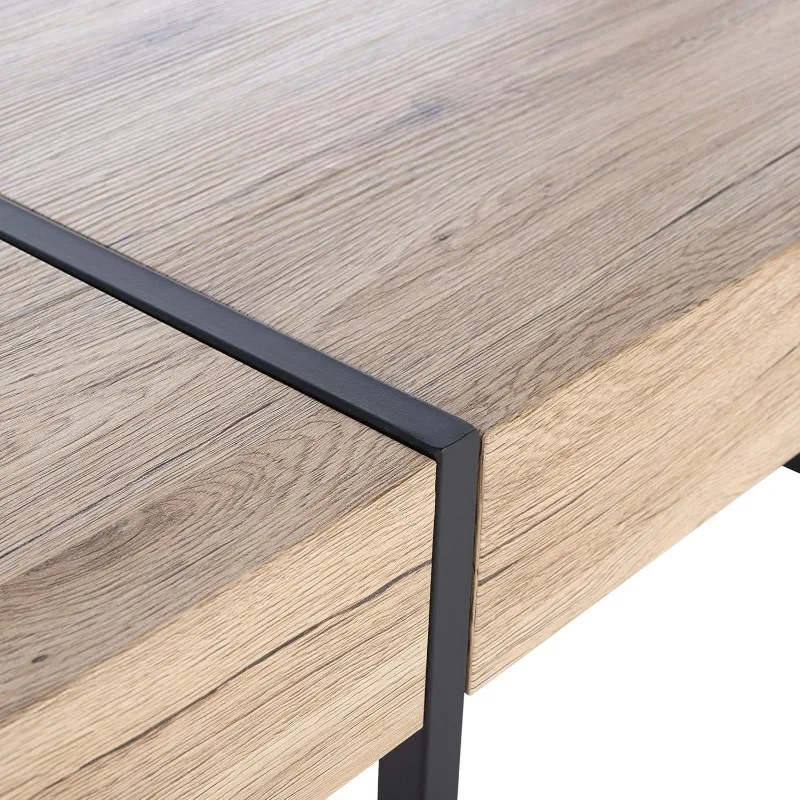
Color Strategies: Palettes That Complement and Expand
The right color scheme can enhance your black coffee table while making your small space feel larger and more cohesive. Consider these effective color strategies:
Light Neutrals for Contrast and Space:
Surrounding your black table with lighter neutral tones—creams, taupes, soft grays—creates dramatic contrast that highlights the table’s silhouette while keeping the space feeling open and airy. This high-contrast approach makes each element more distinct and can actually make a room feel larger.
Strategic Color Accents:
Introduce carefully chosen color accents that reference authentic mid-century palettes. Consider mustard yellow, olive green, burnt orange, or teal—colors that harmonize with black while adding controlled visual interest. Limit yourself to 2-3 accent colors for a cohesive look.
Sophisticated Monochromatic Layers:
Create depth through varied tones of the same color family. A room featuring different shades of gray alongside your black table creates sophisticated dimension without overwhelming a small space. Add textural variation to prevent flatness.
Metallic Integration:
Warm metals like brass and gold create striking contrast against black surfaces while adding luminosity to small spaces. Even small metallic accents—a brass bowl, bronze figurine, or gold-framed artwork—can elevate the entire aesthetic.
When decorating black mid-century coffee tables, consider using lighter objects on the table’s surface to create balance with its dark base. This approach prevents the heavy feeling that can come from too many dark elements clustered together.
Remember that color perception changes throughout the day based on natural and artificial light. Test potential color schemes under different lighting conditions before committing to ensure they enhance your space at all hours.
Complementary Furnishings: Furniture Pairings That Enhance
Creating a harmonious small space around your black mid-century coffee table requires thoughtful selection of complementary furniture pieces. These pairings should balance visual weight while maintaining consistent design language:
Sofa and Chair Selection:
– Choose seating with elevated legs that mirror your coffee table’s profile
– Consider armless or slim-armed pieces that consume less visual space
– Look for medium-toned upholstery that bridges between black table and lighter elements
– Select pieces with similar line quality (angular or curved) to your table
Material Harmony:
– Echo your table’s wood tone in small doses elsewhere in the room
– Balance cool black finishes with warm wood, brass, or textured fabrics
– Consider transparent materials like acrylic or glass for auxiliary furniture to reduce visual weight
– Limit material palette to 3-4 types for cohesion in small spaces
Scale Considerations:
– Choose sofas and chairs with proportional scale to your table and room
– Consider apartment-sized furniture specifically designed for smaller footprints
– Look for tapered or straight legs that echo mid-century aesthetic
– Ensure appropriate height relationships between seating and table
Space-Saving Alternatives:
– Floor cushions or poufs that can tuck under the coffee table
– Wall-mounted lighting instead of floor lamps
– Nesting side tables that can be repositioned as needed
– Dual-purpose pieces like storage ottomans
The key is maintaining proportional balance—your mid-century modern black coffee tables should feel like an integral part of a thoughtfully composed arrangement, not an afterthought or oversized statement piece. Each piece should relate to the others through shared design elements, scale, or material quality.
Mid-Century Modern Lift Top Coffee Tables, Mid-Century Modern Square Coffee Tables
$454.73 Select options This product has multiple variants. The options may be chosen on the product pageMid-Century Modern Nesting Table Sets, Mid-Century Modern Round Coffee Tables
$462.57 Select options This product has multiple variants. The options may be chosen on the product pageMid-Century Modern Black Coffee Tables, Mid-Century Modern Rectangular Coffee Tables
$272.43 Select options This product has multiple variants. The options may be chosen on the product pageMid-Century Modern Lift Top Coffee Tables
$1,101.12 Select options This product has multiple variants. The options may be chosen on the product pageMid-Century Modern Round Coffee Tables, Mid-Century Modern Small Coffee Tables
$452.73 Select options This product has multiple variants. The options may be chosen on the product pageMid-Century Modern Round Coffee Tables, Mid-Century Modern Solid Wood Coffee Tables
Price range: $522.31 through $559.78 Select options This product has multiple variants. The options may be chosen on the product page
Foundation Elements: Rugs and Flooring Considerations
The right foundation dramatically affects how your black mid-century coffee table functions in your space. Thoughtful rug selection creates visual boundaries, adds warmth, and protects flooring while complementing your table:
Size Guidelines:
– For conversation areas, choose a rug large enough for all furniture legs to rest on it completely
– In very small spaces, ensure at least the front legs of seating pieces sit on the rug
– Allow 12-18 inches (30-45 cm) of rug to extend beyond the coffee table on all sides
– For round tables, round or square rugs both work well; match the geometry or deliberately contrast
Pattern Scale:
– In smaller rooms, choose smaller-scale patterns or subtle textures that don’t overwhelm
– Consider solid colors with interesting texture rather than bold patterns
– If using patterns, ensure they complement rather than compete with your table’s clean lines
– Look for patterns with hints of black that will tie in with your table
Texture Considerations:
– Flat-weave rugs provide stable surface for coffee tables with thinner legs
– Low-pile options are practical for easy furniture movement and door clearance
– Consider natural fibers like wool or jute that provide texture without busy patterns
– Lighter colored rugs create appealing contrast with black furniture
For homes where rugs aren’t practical, consider furniture pads to protect flooring and reduce noise. Cork or felt protectors can prevent scratching while maintaining the clean aesthetic of your mid-century piece.
Illuminating Your Space: Lighting to Highlight and Balance
Strategic lighting transforms how a black coffee table functions in a small space, creating ambiance while ensuring the dark surface doesn’t become a visual void. Create a comprehensive lighting plan with these approaches:
Layered Lighting Strategy:
– Ambient lighting (overhead fixtures or recessed lights) provides general illumination
– Task lighting (adjustable reading lamps) offers functional light for activities
– Accent lighting (focused spots or table lamps) highlights the coffee table and creates atmosphere
Space-Saving Options:
– Wall-mounted sconces that free up table and floor space
– Pendant lights that illuminate from above without footprint
– Small-scale table lamps with narrow profiles
– Under-furniture LED strips that create a floating effect
Shadow Management:
– Position lights to minimize harsh shadows cast by the table
– Use multiple light sources from different angles to balance illumination
– Consider uplighting to bounce light off walls and ceilings
– Adjust lighting angle to reduce glare on polished table surfaces
Light Temperature:
– Warm light (2700-3000K) enhances the rich tones in black furniture
– Avoid cool white lights that can make black surfaces appear flat or harsh
– Consider adjustable temperature bulbs to adapt to different times of day
– Use slightly brighter lighting around dark furniture to maintain balance
Well-placed lighting not only makes your black coffee table more functional but also transforms it into a more dynamic design element throughout the day and evening.
Practical Solutions: Maintenance and Common Concerns
Owning a black mid-century coffee table in a small space comes with specific practical considerations. Here are solutions to common questions and concerns:
Q: How do I prevent my black table from making my space feel heavy?
A: Position your table on legs that create visual space underneath, pair it with lighter-colored surrounding elements, and ensure adequate lighting. Keeping the tabletop relatively clear also prevents visual heaviness.
Q: How do I deal with dust and fingerprints that show easily on black surfaces?
A: Keep a microfiber cloth handy for quick daily wipes. For fingerprints, a solution of equal parts white vinegar and water works well without damaging finishes. For wood tables, use appropriate wood cleaners that don’t leave residue.
Q: What’s the best way to protect the surface from scratches and water rings?
A: Use coasters consistently for all beverages. Consider clear protective pads under decorative objects that might scratch. For wood tables, apply an appropriate protective wax or polish seasonally. Felt pads on the underside of all items placed on the table provide additional protection.
Q: My room has limited natural light. Will a black table work?
A: Yes, with proper artificial lighting. Ensure your space has adequate layered lighting, including some directed specifically at the table. Consider a table with a slightly reflective finish rather than matte to bounce available light.
Q: How can I refresh or customize an older black mid-century table?
A: For wood tables, refinishing with modern non-toxic stains can restore luster. Hardware replacements (new drawer pulls or legs) can update the look while preserving mid-century character. Consider adding a custom glass top for protection while maintaining the original appearance.
Black Mid-Century Table Showcase: Inspiring Small Space Examples
These real-world applications demonstrate how black mid-century coffee tables solve specific small space challenges while enhancing style:
Studio Apartment Solution
In a 450-square-foot studio, a round black mid-century coffee table with tapered legs serves multiple roles throughout the day. Its 32-inch diameter provides ample surface without overwhelming the space, while its lift-top feature transforms it into a work-from-home desk when needed. The open shelf beneath stores laptops and work materials out of sight during off hours.
Family-Friendly Small Living Room
A compact living room for a young family features a rectangular black coffee table with rounded corners for safety. The durable matte finish hides fingerprints between cleanings, while built-in drawers keep toys and remotes contained. At 38 inches long, it provides enough surface for family game nights without dominating the modest seating area.
Urban Apartment with Entertainment Focus
An 800-square-foot city apartment uses a set of nesting black mid-century tables that can separate for parties or combine for everyday use. The main table’s glass top maintains visual lightness while reflecting light, and the entire set tucks together when not hosting. This arrangement maximizes flexibility while minimizing footprint.
Home Office/Living Room Combo
In a multifunctional space serving as both office and living area, a black storage coffee table with tambour doors acts as the room’s anchor. During work hours, office supplies stay hidden behind sliding doors, while evenings and weekends see the surface transformed for relaxation and entertaining.
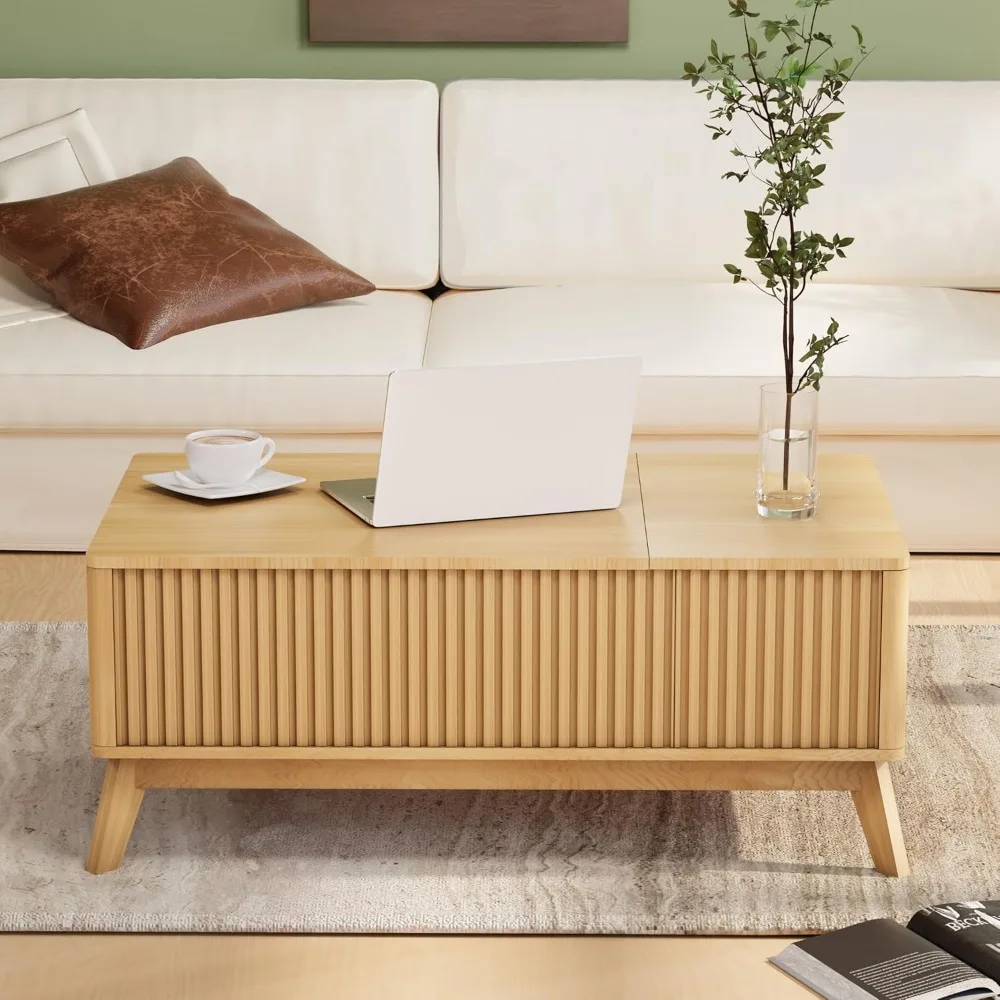
These examples showcase the versatility of best compact mid-century coffee tables in addressing specific lifestyle needs within spatial constraints. Each solution demonstrates how thoughtful selection can dramatically enhance both functionality and aesthetic appeal.
Frequently Asked Questions
Is black furniture really suitable for small spaces?
Yes, black furniture can work beautifully in small spaces when properly balanced with lighter elements. The key is creating contrast that defines the piece while ensuring adequate lighting and visual space around it. Black mid-century pieces with elevated profiles often work better than bulkier dark furniture styles.
What’s the minimum room size for a black mid-century coffee table?
Even very small spaces can accommodate appropriately sized coffee tables. For extremely limited areas, look for tables no larger than 30 inches in diameter or length, and ensure at least 18 inches of clearance for pathways around the piece. Round or oval shapes often work better in the tightest spaces.
How do I coordinate a black table with light furniture?
Black and light furniture create beautiful contrast when connected through consistent elements. Incorporate black accent pieces (picture frames, lamps, or decorative objects) throughout the room to create visual links to your table. Consider textiles with patterns that include both black and your lighter furniture tones to bridge between them.
What’s the difference between authentic mid-century and modern reproductions?
Authentic vintage mid-century tables typically feature higher quality woods, hand-crafted joinery, and naturally aged patinas. Modern reproductions often incorporate contemporary materials and manufacturing techniques while honoring the original aesthetic principles. Quality reproductions can be excellent options that offer similar style with modern durability.
How do I protect my black table surface from scratches and rings?
Use felt pads under all decorative objects, employ coasters consistently, and consider placemats for dining. For wood tables, apply appropriate protective finishes according to manufacturer recommendations. Glass toppers offer excellent protection while preserving visibility of beautiful wood grain or design details.

